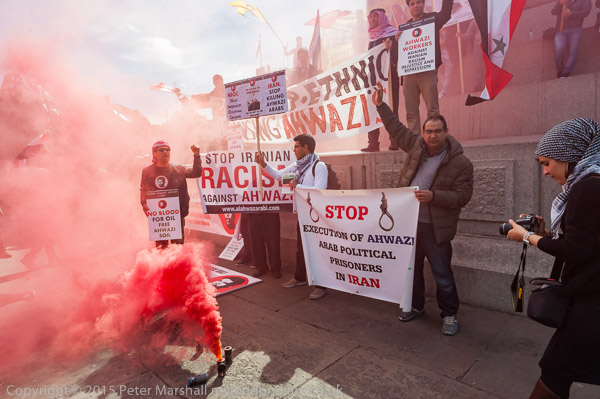No 3rd Runway Heathrow 70th Birthday
Harmondsworth, London. Mon 30- May 2016
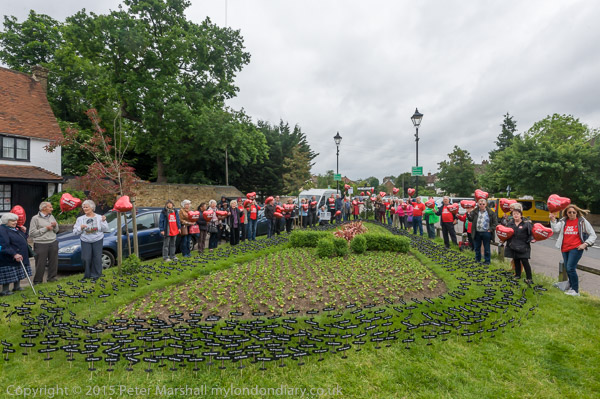 70
red balloons for 70 years of Heathrow's nuisance, 750 black planes for homes
the 3rd runway would take.
70
red balloons for 70 years of Heathrow's nuisance, 750 black planes for homes
the 3rd runway would take.
more pictures
HACAN and anti-3rd runway campaigners in Harmondsworth 'celebrated' Heathrow’s 70th Birthday with 70 ‘No 3rd Runway’ balloons and over 750 black airplanes on the village green, representing the number of homes that would be destroyed.
The event started with introductory speeches by John Steward of HACAN and Neil Keveren of Stop Heathrow Expansion, before the protesters went into the FIve Bells pub to collect the 70 red heart-shaped balloons in honour of Heathrow's 70 years of noise and pollution blighting south-west Middlesex, coming out to stand with them on Harmondsworth Village Green.
A number of the local residents present were already living in Harmondsworth when Heathrow began here 70 years ago. Fittingly, Heathrow began as a lie, initially given permission as a military airport in World War 2, it was never intended or needed for this purpose, but was from its inception seen as a way to circumvent any objections to a civil airport being developed on this site.
Heathrow over the years expanded by lie after lie. Every expansion was said the be the last the airport would ever need and promises made to the local population and to enquiries that there would be no further growth. T4 was promised to be the last - but then came the application to build T5. With this came the promise that Heathrow would never ask for another runway - but this was broken before T5 had opened. The enquiry into the third runway was said to be final - but while the local community were still celebrating the victory - and David Cameron was saying " No Ifs, No Buts, No Third Runway", Heathrow Airport was already plotting the setting up of a new inquiry that would somehow against all the evidence come up with the result they wanted - the Davies Commission.
John Stewart held up some of the gifts that people had donated for Heathrow on its 70th birthday - a bottle of empty promises, a box of 'after 11.30 mints' for the night flights which currently are supposed to end at that time - and there was an alarm clock stuck at 4.30am for when the jets wake up people in the area.
There were other similar gifts, and a moving speech from Armelle Thomas, who stood through the protest holding a photograph and the medals of her late husband, Tommy, who had given up joint nationality in 1939 to fly as a rear gunner in Lysanders. The two met long after the war when Tommy was working at Heathrow for BEA, and lived together in Harmondsworth until Tommy's death last September. Her gift was a piece of the cake from last year's protests which she had visited Heathrow bosses to give them, but they had refused to see her, and it had been in her refrigerator since.
The final gift was a novel invention, The Heathrow Adobe Hat. Research has shown that aircraft noise has a deleterious effect on the performance in schools close to the flypath, and Heathrow has presented some with Adobe Huts which apparently reduce the effect of noise. The Heathrow Adobe Hat takes this a step further, bringing the amelioration to the individual pupil level. with a hat that covers the head connected to a portable air purification unit in a small suitcase, one side of which is covered with grass as a part of the Heathrow bio-diversity programme. It was modelled to great applause by Neil Keveren's daughter, wearing it along with her school uniform.
People then moved a few yards across the village green to plant over 750 small black aircraft outlines in the grass, one for each home that the proposed third runway would destroy. It was quite an impressive number in the grass, and those people who had managed to keep hold of their balloons stood around holding them. It had been decided not to release the helium-filled balloons for environmental reasons, but a number had slipped from people's hands during the event or become untied. Those that remained where now taken back inside the Five Bells Pub where we all returned for a free lunch.
There were two Heathrow 3rd Runway cakes celebrating '70 years of unrelenting aircraft noise for local communities' at the lunch, which were cut by representatives of the various groups present, including those from Binfield, Teddington, Chiswick and Hammersmith as well as the Heathrow villages organisations. One cake was labelled 'A Huge Mis-cake' and the second 'Half-baked plan for third runway'.
Afterwards a few of us stayed for a guided tour of the village, showing how
the expansion plans would destroy much of it, leaving the remaining buildings
- including its historical center, with the two pubs, some 17th - 19th century
housing, a fine church, part Norman and one of the nation's most important
listed buildings, the great tithe barn, the largest wooden structure in the
country, perilously close to the new busy runway, unlivable in and at serious
danger from vibration.
more pictures
[Pictures of the tithe barn, an English Heritage property, are not available for commercial use.]
Walk the Crane
Hatton & Feltham, Middlesex. Mon 28 May 2016
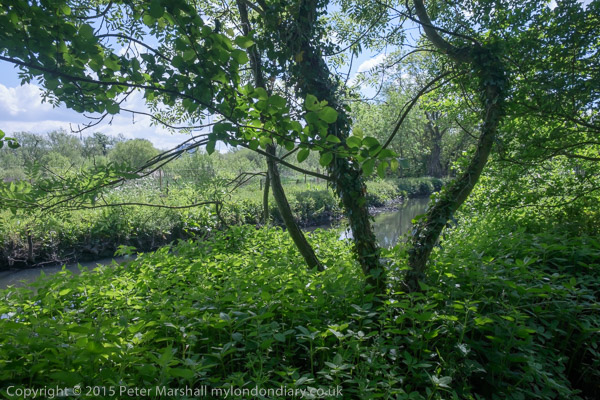
The River Crane
more pictures
It looks a rural idyll, but every minute or so, its peace is shattered as perhaps over 500,000 kg of aircraft thunders overhead to touch down on Heathrow's southern runway a mile and a quarter away.
I used to play here as a kid, sliding on scraps of corrugated iron down the small gravel hills, riding bicycles around the paths, playing war games (it was the 1950s and the war seemed close) and more. The brick and concrete buildings were the remnants of the gunpowder mills here, which only closed down in the 1920s; my father who grew up down the road in Hounslow remembered at least one hug explosion, and I paid homage to the tradition with some smaller devices using weedkiller which created a number of smaller events which only slightly damaged the remains.
Here in 1530 the Duke of Northumberland brought water from the Colne to supplement the flow of the River Crane, possibly in part for the mills here, but mainly for his mills at Isleworth, though I doubt he did much digging himself. A few years back I stopped at the rail overlooking the lake close to where a millwheel once was powered by this flow into the Crane and watched spellbound for ages as a kingfisher dived repeatedly from a branch into the water below, sometimes emerging with a small fish flapping in its beak. But there were few birds around today, and little to watch.
Now the woods - we always knew them as the 'Crown and Sceptre Woods' are a nature reserve and the London Loop leads through the middle of what is now officially Donkey Wood. The Crown and Sceptre is now a supermarket, and its a better name than Tesco Wood.
Emerging onto the Staines Road at Baber Bridge we turned towards London, and walked the narrow and dusty road. The Romans followed, possible made, the same route, though they would have suffered rather fewer heavy goods vehicles. A few hundred yards on, we crossed the road and walked on to Hounslow Heath.
Or at least we didn't. We walked onto the huge hole left when the heath was dug for gravel, then filled with London's rubbish, covered with topsoil and sculpted into a municipal golf course. It was pretty empty as we made our way south and got slightly lost when the path unexpectedly divided and we made the wrong choice.
It didn't matter much, the course was pretty empty and we stood little risk of being hit by a golf ball, but we did need to find a couple of bridges across the several streams that run through it (somewhat randomly for the next few miles, the larger stream of the river is called the Crane and any smaller course the Duke of Northumberland's River.)
We found a bridge- though not the one we intended, crossed it, and then with
a little help from a central European couple enjoying the sun on a large area
of grass, made our way to the second, which was our destination, and took
us across the main course of the Crane - and we were now again on the London
Loop, and made our way back, across the Staines Rd and under the flight path
to return to Hatton for pub grub. And beer.
more pictures
Walk the City
City of London. Sun 22 May 2016
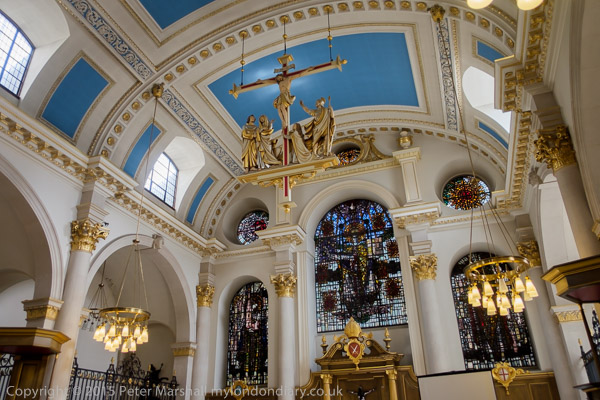
St Mary Le Bow
more pictures
I walked with my wife as she took part in the annual sponsored walk around central London as a part of Christian Aid Week. This was I think the 18th such annual walk, and she has been on 17 of those, and I've usually accompanied her. The route does change a little each year but often involves many of the same locations. This year's walk was around 6 miles and included several London places of religious worship, including one I've not visited before, the only Roman Catholic church in the city, area.
Only one of the places we went inside did not allow photography, the Jewish synagogue at Bevis Marks. I've been allowed to photograph in other synagogues and the reason for the ban may well be commercial rather than religious, as postcards of the interior were on sale inside the synagogue. We only walked around the outside of St Paul's Cathedral, but photography isn't allowed inside there either, probably because of overcrowding.
I didn't take many pictures - most of the churches I've photographed several
times before - and here are just a few of them.
more pictures
Housing is a Mental Health Issue
Stratford, London. Sat 21 May 2016
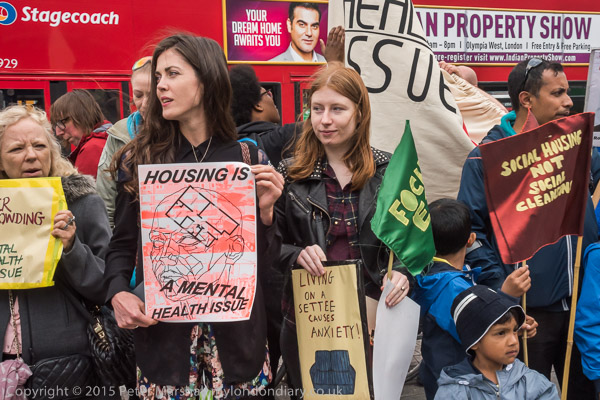
'Your Dream Home Awaits You' says the ad, but for many
housing is rather more of a problem
more pictures
Focus E15 housing campaigners in Stratford, London rally and march in Stratford during Mental Health Awareness Week against Newham council's policy of social cleansing and highlight the mental health issues that arise from housing problems.
They say despite huge building developments in the area and some council estates emptied of tenants, Newham is causing mental health problems for vulnerable people through evictions and placements with insecure tenancies and away from families, friends and support systems in cities and towns across the UK.
After a short rally with speeches from several housing campaigners, as well as songs and poems, the group marched around central Stratford, pausing briefly outside some of the new high-rise housing being built largely for the rich - while those unable to afford sky high market rents are being forced out. The tall blocks also create their own inhospitable micro-climates at ground level, and when the march approached one of the most recent, gusts of wind tore one of the banners in two.
The march ended on Stratford Broadway, on the pavement outside Wilco's, where
Focus E15 hold their regular Saturday morning street stall.
more pictures
March Against Monsanto Rally
Downing St, London. Sat 21 May 2016

There were only a few in London for the worldwide
March against Monsanto
more pictures
Protesters against the corporate control of our food system held a rally at Downing St against Monsanto, who they say dominates the market for seeds and agrochemicals at the expense of small scale farmers and communities around the world and is forcing harmful pesticides and genetically modified seeds on farmers.
There was little publicity for the London event, part of several hundred
protests worldwide against Monsanto today. There were also several other events
on in London at the same time. But there were certainly some good speeches
and some dedicated activists.
more pictures
'Dosta, Grinta, Enough!'
Parliament Square, London. Sat 21 May 2016
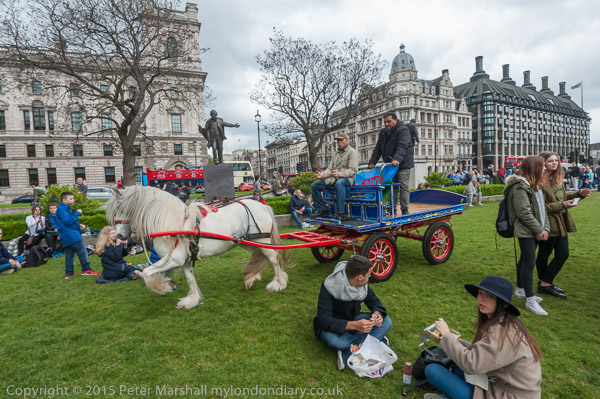
A horse trots around Parliament Square pulling a cart
- but horses aren't allowed
more pictures
Four horse drawn vehicles came to Parliament Square for the protest by Roma, Gypsies and Travellers against the hardening attacks against their way of life. Heritage wardens and police told them it was was against bylaws to bring horses on to the square.
After a short rally in the centre of the square they four horse-drawn vehicles then led protesters in repeated circuits of the roadway around the square before leaving as the rally on the corner of the square started.
Changes which have allowed local authorities to stop providing traveller sites, and laws against fly-grazing have made finding places to stay and moving around the country much harder. While some legislation had encouraged them to buy land for sites, as at Dale Farm, local planning laws have been used in a discriminatory fashion to prevent them using land even when they own it.
The ‘Dosta, Grinta, Enough!’ protest was against changes to the Gypsy and Traveller planning guidance and other actions by the government which are an attack on their ethnicity and way of life and they call for an end to 500 years of persecution.
Tampon tax now Osbourne!
Parliament Square, London. Sat 21 May 2016
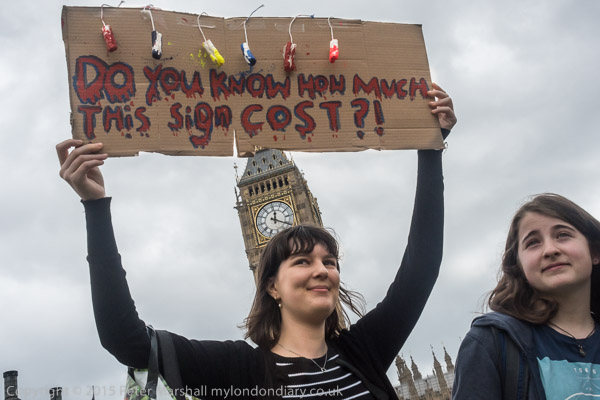
Campaigners pose for pictures in Parliament Square
before marching to Downing St to present their demands
more pictures
Campaigners met in Parliament Square to urge the government to fulfill their pledge to axe the tax on tampons, before marching to present a letter to Downing St. The promise came after a massive campaign and lobby which have resulted in the removal of regulations preventing the removal of tax, but the tax has still not been removed.
Among the protesters were a group from 50:50 Parliament, led by Frances Scott,
calling for equal representation of women and men in Parliament. If there
were more women in Parliament there would not be taxes such as this - and
rather less of the public-school bickering that often dominates the House
of Commons.
more pictures
Foil Vedanta at Jaipur Literary Festival
Royal Festival Hall, Southbank, London. Sat 21 May 2016

Samendra Das leads Foil Vedanta protesters away from
stage after a short protest there
more pictures
Foil Vedanta protest in the Royal Festival Hall against Vedanta's sponsorship of the Jaipur Literature Festival. They say Vedanta, the most hated company on Earth, causing pollution, illness, displacement, poverty and deaths by its mining operations, sometimes criminal, in India, Zambia, South Africa and Australia, is attempting to whitewash its image by sponsorship of the festival.
As I arrived they were at the front of the main presentation space in the Clore Ballroom, briefly interrupting a presentation there to explain their opposition to Vedanta which was the major sponsor of the festival. Earlier Foil Vedanta and Round Table India has sent an open letter the authors who had agreed to appear, signed by around 50 mainly Indian writers, poets, academics and activists, informing them of Vedanta's criminal operations, and calling on them to withdraw. Several had done so, but others continued to support the festival, though some were expected to criticize Vedanta in their presentations.
The protesters withdrew to the entrance to the sunken area holding posters
and handing out leaflets, watched by security. Apart from trying to move them
a little more out of the way, there seemed to be no attempt to stop the protest,
and they handed out leaflets to those attending, as well as briefing several
journalists.
I had to leave for other protests as Foil Vedanta were intending to make another
intervention as a speaker closely linked to Vedanta was due to appear, and
the protest was due to continue for a couple more hours.
more pictures
Cleaners protest at Capita
City, London. Fri 20 May 2016
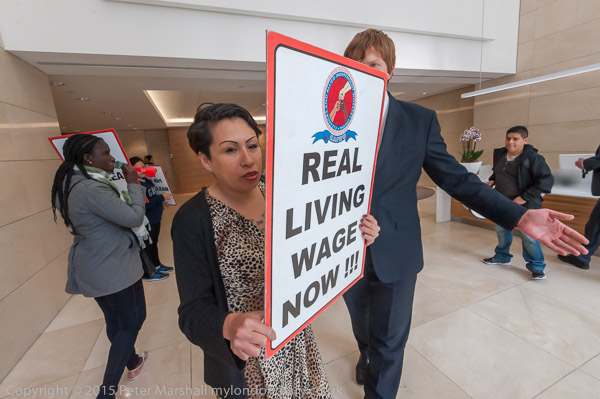 A
security guard tries to move a woman carrying a CAIWU poster calling for a
real living wage now
A
security guard tries to move a woman carrying a CAIWU poster calling for a
real living wage now
more pictures
Members of the Cleaners and Allied Independent Workers Union protest at the St Paul's office of Capita after contractor Mitie sacked two of the only three African workers and reduced the hours of the third, allegedly on racist grounds, and demand cleaners there be paid the London Living Wage.
Seven or eight protesters rushed into the foyer of the shared offices at 65 Gresham St, leaving others, including some who clean that building, protesting on the pavement outside, where they held a banner and posters and blew plastic horns.
Inside the foyer there was also a noisy protest, and the protesters tried to ignore the security staff and handed out flyers about the sacking and reduction in hours to workers as they went in and out for lunch. Most of the workers were from other companies that have offices in the building rather than Capita, and almost all took the leaflets and looked at them with interest.
After around 5 minutes of protest in the foyer, two security men persuaded CAIWU General Secretary Alberto Durango to leave, pushing him firmly towards the door, and the other protesters shortly followed him to continue the protest outside. A few minutes later they moved around the corner to the rear entrance of the office block, where the protest continued for another quarter of an hour. Shortly after they arrived there, a police officer arrived and talked with both protesters and security staff, before standing back to watch and take notes, and to maintain passage along the pavement as well as trying to prevent any protesters being run over by the occasional car going past.
The protesters then returned for a final session of protest at the front entrance which was continuing as I left around a quarter of an hour later. Shortly before I left, a man in a suit walking past shouted at Alberto Durango to stop making a noise and tried to grab his microphone; Alberto turned away and the man then approached me telling me I should not be taking pictures. I photographed him standing directly in front of me, and he walked past and grabbed the shoulder of a protester who was blowing a plastic horn. Alberto and I both walked towards him, and the police officer watching the protest came up and intervened, telling the man to stop interfering with the protest. He took him to one side and spent several minutes talking to him before making sure he left the area.
Further protests and strike action are expected until Capita re-instate the
sacked worker, abandon attempts to impose an impossible workload and improve
conditions of service, including paying the London Living Wage.
more pictures
No More Deaths from Benefit Cuts
Tottenham Court Rd, London. Thu 19 May 2016
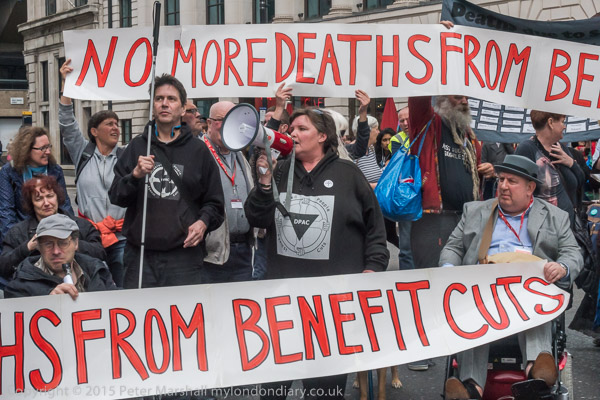
Paula Peters (centre) speaks between the two banners as the protest blocks
Tottenham Ct Rd
more pictures
Delegates at the TUC disabled workers conference led by activists from Disabled People Against Cuts (DPAC), Mental Health Resistance Network (MHRN) and Winvisible (Women with visible and invisible disabilities) marched from Congress House to Tottenham Court Road calling for an end to government benefit cuts which have led to the deaths of many disabled people - including 2 DPAC members the previous day.
There were speeches and chanting as they blocked traffic, with pedestrians , including workers on their break from nearby sites, gathering and applauding and some drivers hooting in support. Many people across the UK now realise the terrible treatment of the disabled and all benefit claimants by the DWP, using unfair tests administered by half-trained assessors designed to trick, the target-driven imposition of benefit sanctions for trivial reasons, often those entirely beyond the control of the claimants, and the withdrawal of various benefits. And although the minister responsible for the worst of those crimes has now resigned, there is little reason to hope that his successor will be any less inhumane.
For any still sceptical about the effects of government policies and their administration, one of the banners carried the names of around a hundred of those known to have died because of sanctions and benefit cuts, with photographs of some of them. But many more have perished, and more still have only kept alive through the charity of friends and neighbours, through the many food banks around the countries, and charities which feed people on the streets - something some councils have tried to make illegal.
Police diverted traffic away from the area and otherwise kept a low profile
for half an hour, only turning up to talk with the protesters as they were
preparing to leave to return to the afternoon sessions at the TUC.
more pictures
Greenpeace 'Sinking Cities' banners at BM/BP show
British Museum, London. Thu 19 May 2016

Greenpeace banners re-christen the BP sponsored exhibition
'Sinking Cities'
more pictures
At first I couldn't see what all the fuss was about as I walked past the police tape outside the British Museum, but when I studied the very professionally produced banners hanging down each of the seven columns of the famous portico I realised that this was a dramatic intervention on the opening day of the British Museum/BP exhibition 'Sunken Cities', a part of BPs activities to give it a more acceptable image.
BP is one of the world's major polluters, through its own activities and oil catastrophes such as that in the Gulf of Mexico, but more importantly by its lobbying for the continuing use of oil and the supply of huge quantities of climate-harming petrol and diesel - including some from filthy sources such as tar sands.
The posters for the forthcoming 'Sunken Cities' exhibition were already up when I last visited the museum with BP or Not BP? last December, and I took a few pictures in front of them. Clearly this was going to be a controversial sponsorship, and the banners reading Sinking Cities, New Orleans, Boscastle, Manilla, Maldives, Hebden Bridge and Sinking Cities again, listing some of those places in the UK and across the world recently flooded due to global warming induced climate change was I think the third major protest even though this was only the first day the show would have been open to the public.
The whole museum had been closed to the public and people were being told
it would not reopen that day. I felt a little sorry for those groups milling
around on the pavement, some of whom had travelled some distance to see the
exhibition, but felt that the closure was an unnecessary panic response -
there are other entrances to the museum and all that was necessary was the
closure of the portico area and some minor diversions. The climbers on the
columns were obviously experienced and operating safely and apparently without
damage to the museum structure. And their banners were certainly an improvement,
far more professional than the two rather dull large official display boards
that can be seen below them.
more pictures
Canada House vigil condemns CETA
Canada House, Trafalgar Square, London. Mon 16 May 2016
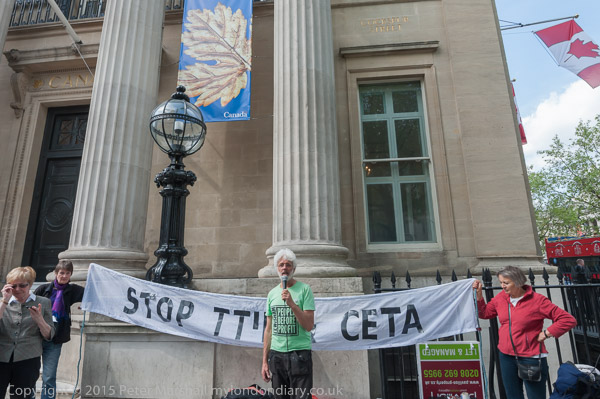
Protesters with banner under the maple leaves at Canada
House
more pictures
A protest and vigil outside Canada House condemned the secret CETA trade deal currently nearing completion between Canada and the EU. Negotiations have been in secret and the deal would allow the big corporations to force privatisation of public services such as the NHS and prevent governments adopting environmental legislation that might harm company profits.
The deal will not be voted on in the UK parliament and ours is the only EU
Parliament that cannot veto CETA or TTIP. The day of action was continuing
after the vigil with an evening rally, but I had to leave after the first
few speeches at the vigil, including those by Maude Barlow of the Council
of Canadians and London Green MEP Jean Lambert.
more pictures
Banner Drop against CETA & TTIP
Westminster Bridge, London. Mon 16 May 2016
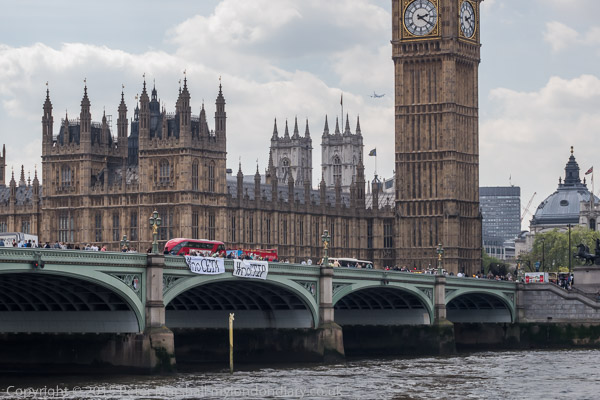
'#noCETA #noTTIP' banners in front of the Houses of
Parliament
more pictures
As part of a day of protest against the Canada/EU and UAS/EU trade deals
being negotiated in secret, activists lowered banners over Westminster Bridge
with the messages '#noCETA #noTTIP' and '#noCETA HANDS OFF DEMOCRACY'. Even
MPs are being kept in the dark about the details of these deals, and the UK
Parliament will almost certainly not be allowed to vote on them; it is the
only EU Parliament that cannot veto CETA or TTIP.
more pictures
BIS protest against CETA & TTIP
Dept of Business (BIS) Westminster, London. Mon 16 May 2016
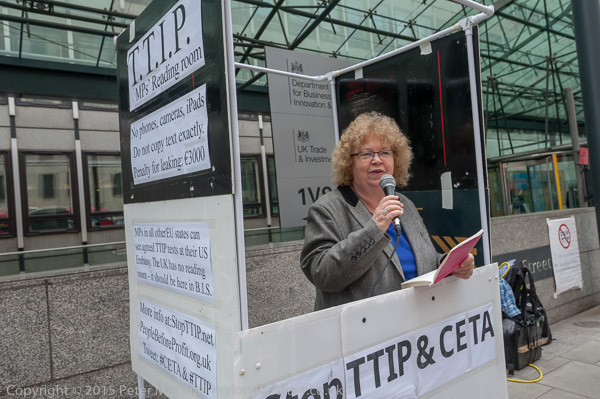
Green MEP Jean Lambert speaks inside a mock 'MPs reading
room' - promised by BIS but not provided.
more pictures
A day of protest by activists opposed to the discredited US/EU TTIP and CETA Canada EU secret trade deals begins at the Dept of Business (BIS) where a small cell was constructed to dramatise the fact that the access for UK MPs has never been provided. UK Mp's are the only EU MPs who have been denied access and the UK parliament is the only EU parliament that cannot veto CETA or TTIP.
The protesters were not allowed to enter the building to present their letter reminding the minister of the promise to set up the MPs reading room, but a few minutes later a friendly and polite civil servant came out to take it from them.
There were a few arguments between protesters and security about putting
banners on the wall and later across the vehicle exit from the building, with
security threatening to call the police at one point. If they did, they police
failed to arrive before the protest ended
more pictures
Topshop protest after cleaners sacked
Oxford St, London. Sat 14 May 2016
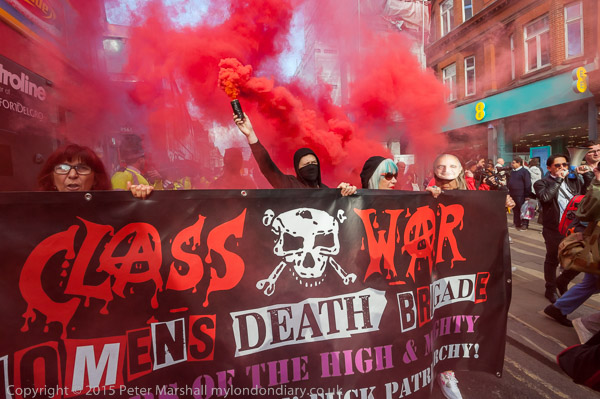 A
red flare behind the Womens Death Brigade banner as the protesters head for
John Lewis
A
red flare behind the Womens Death Brigade banner as the protesters head for
John Lewis
more pictures
Protests took place outside Topshop in Oxford St and other stores around the country following the suspension of two cleaners who protested for a living wage; one has now been sacked.
Other groups joined the cleaners union UVW in the protest including Class War and cleaners from the CAIWU and other trade unionists. Ian Hodson, General Secretary of the BWAFU and Shadow Chancellor John McDonnell were among those at the London protest.
The protest began outside the Oxford St Topshop, which was heavily defended by police, as well as by extra illegal security guards wearing no ID. Several hundred protesters held up banners and placards and with the help of the police blocked the entrance to the shop. They made a lot of noise but made no serious attempt to enter the building.
After a while some of the protesters, led by the Class War Womens Death Brigade moved onto the road, blocking it for some minutes as police tried to get them to move. The whole group of protesters then moved to block the Oxford Circus junction for some minutes until a large group of police arrived and fairly gently persuade them to move.
They did, but not in the direction the police had wanted, instead marching west along Oxford St. As they approached John Lewis, a red flare was set off and then protesters crowded around the entrance, protesting noisily. John Lewis is another major store that allows its cleaning contractor to pay its cleaners low wages, with poor conditions of service and poor management, disclaiming any responsibility for workers who keep its stores running.
There were some heated exchanges between protesters and police, but I saw
no arrests, and after a few minutes the protest resumed its march towards
Marble Arch and another branch of Topshop where the protest continued.
more pictures
Refugees Welcome say protesters
Trafalgar Square, London. Sat 14 May 2016
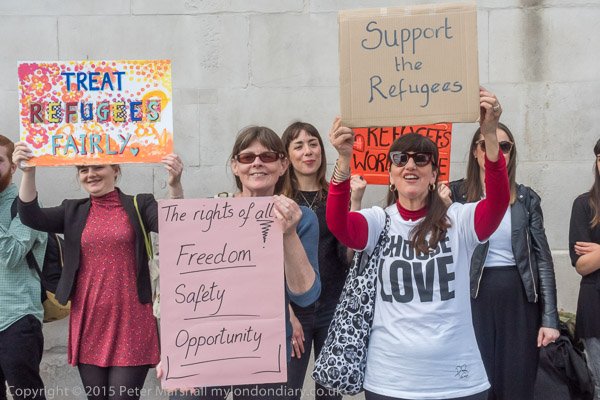
A small group of protesters standing in front of the National Gallery held
posters calling for human rights, fair treatment and support for refugees.
Some held a banner with the message 'free movement for People Not Weapons'.
more pictures
Vegan Earthlings masked video protest
Trafalgar Square, London. Sat 14 May 2016
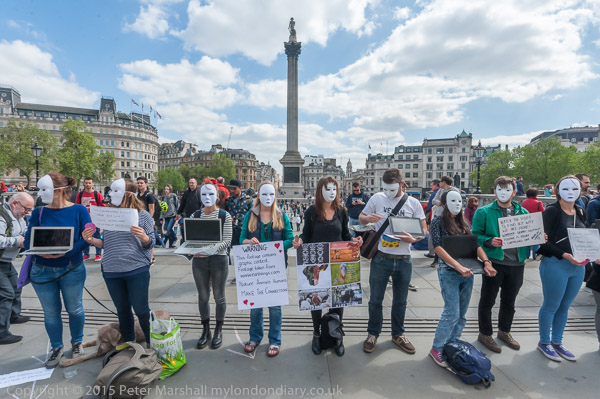
The protesters were standing in a large circle on the
North Terrace
more pictures
Vegans wearing white masks stood in a large circle in Trafalgar Square holding laptops and tablets showing a film about the mistreatment of animals in food production, bullfighting, etc. The protest was organised by London Vegan Actions and posters urged people to stop eating meat to save the environment and end animal cruelty.
Unfortunately bright sun made the laptop screens almost impossible to see
and few small computers have sound that is audible more than a foot or two
away in the large open public square, and the protest was rather less effective,
though the large circle of people standing in white masks did attract attention.
more pictures
68th Anniversary Nabka Day
Oxford St, London. Sat 14 May 2016
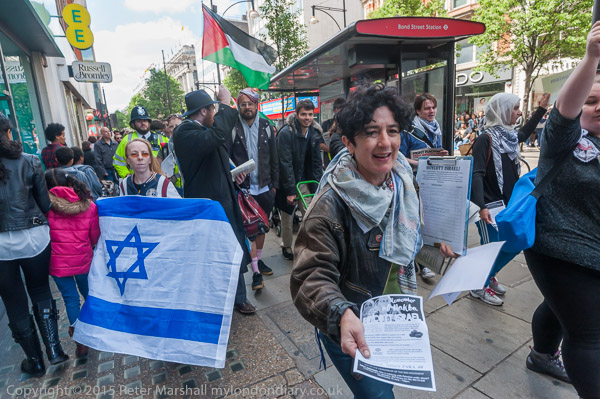 A
woman hands out leaflets about the Nabka at the protest
A
woman hands out leaflets about the Nabka at the protest
more pictures
A protest outside shops supporting the Israeli state made its way along Oxford St from Marks and Spencers, with speakers detailing the continuing oppression of the Palestinian people, and opposing attempts to criminalise and censor the anti-Zionist boycott, divestment and sanctions (BDS) movement.
The event marked Nabka Day, the 'day of the catastrophe', remembering the roughly 80% of the Palestinians who were forced to leave their homes between December 1947 and January 1949, and later prevented by Israeli law from returning to their homes, or claiming their property. It is usually commemorated on May 15, the day following Israeli Independence Day, so this event was a day early, when OXford St would be busier.
Among the protesters were a number of Jews who are opposed to the continuing oppression of the Palestinians by the Israeli government. A small group of counter protesters shouted insults and displayed Israeli flags, accusing the protesters of anti-Semitism, but there was no suggestion of this, with the protest being clearly directed against some actions of the Israeli government and against Zionism, and the event organisers and police clearly trying to avoid confrontation with the counter-protesters, which they were trying to provoke by standing in front of the protest and shouting at them as they moved along the street.
Many UK businesses play an important part in supporting the Israeli government
by selling Israeli goods and those produced in the occupied territories and
in other ways, and their were brief speeches as the protest halted outside
some of them detailing some of these links.
more pictures
Reclaim Holloway
Holloway, London. Sat 14 May 2016
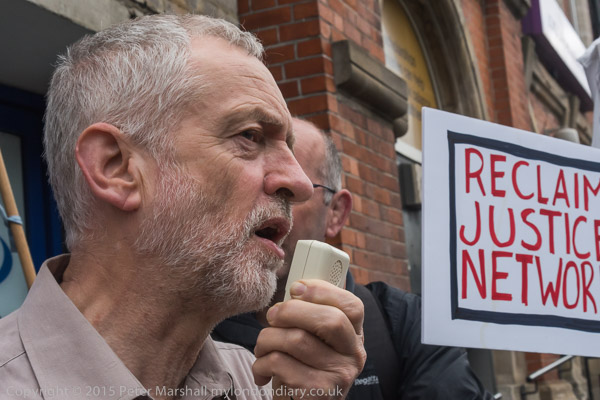
Jeremy Corbyn speaking before the march
more pictures
Jeremy Corbyn spoke outside London Met on Holloway Rd at the start
of the march by Islington Hands Off Our Public Services, Islington Kill the
Housing Bill and the Reclaim Justice Network to HMP Holloway demanding that
when the prison, which is in his constituency, is closed the site remains
in public hands, and that the government replace the prison with council housing
and the vital community services needed to prevent people being caught up
in a damaging criminal justice system.
A group of around a hundred then marched from there to Holloway Prison, apparently
already largely emptied of prisoners, and held a long rally there with speeches
by local councillors, trade unionists and campaigning groups. Islington Council
would like to see the prison site and adjoining housing estate owned by HM
Prisons used for social housing rather than publicly owned land being sold
for private development.
more pictures
Going Backwards on Climate Change
Whitehall, London. Sun 8 May 2016
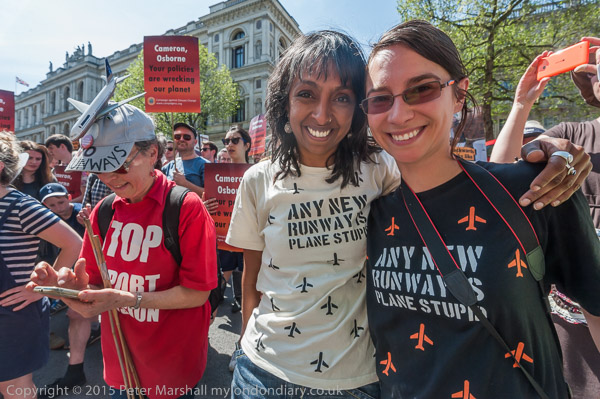
Sheila Menon of Plane Stupid (centre) spoke at Downing
St - there is no need for more airport capacity
more pictures
Protesters marched backwards down Whitehall against UK Governments backtracking over clean energy, which has seen them dropping insulation grants and crippling our green energy programmes while backing climate-wrecking fracking and biomass projects along with proposing massively polluting and unnecessary road and runway projects.
The protesters stopped several times for short rallies addressed by politicians and campaigners, among the Dame Vivienne Westwood, Sheila Menon of Plane Stupid, Labour and Green politicians and Lianna Etkind from Campaign for Better Transport. The march ended in the yard in front of the Dept of Health where there were more speeches and some street theatre.
Before the start of the march there was a very warm reception for Kye Gbangbola, the father of Zane Gbangbola, who was killed when floodwater released hydrogen cyanide from waste landfill in February 2014; the same deadly gas left Kye part paralysed and he spoke from his wheelchair.
The authorities have repeatedly impeded attempts to get at the truth, and
are refusing to give the family legal aid for the inquest. The case raises
much wider questions about the safety of landfill sites across the country
and the lack of proper oversight by local authorities - in this case Spelthorne
Council - and the Environment Agency. Many at the event signed
the petition and there is also a crowdfunding
appeal to enable the family to have proper representation at the inquest,
where the public bodies involved will be spending large sums on legal representation.
They lost their appeal for legal aid despite a letter of support from the
senior coroner for Surrey.
more pictures
Cleaners invade Barbican Centre
Barbican, London. Sat 7 May 2016
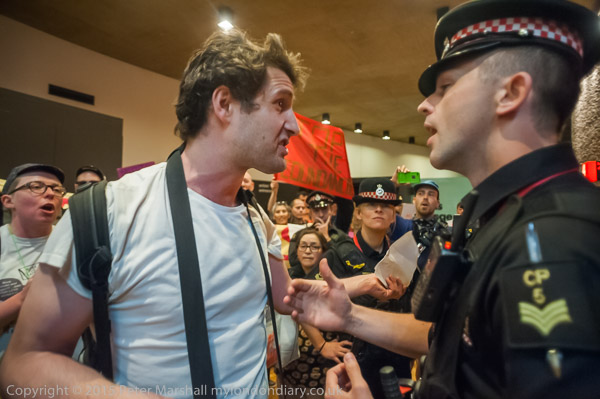
Petros Elia confronts a police officer who is trying
to get the protest to stop
more pictures
Cleaners union UVW staged a protest inside the Barbican Centre, after cleaning contractor Servest proposed making many of the cleaners redundant or severely cutting their hours and pay. Earlier protests at the Barbican had led to the cleaners getting the London Living Wage in January 2016 but the Barbican disclaims any responsibility for the people who clean the building although Servest claims they driving the cuts.
I met the cleaners at Moorgate on their way to the Barbican, and they walked quietly along the road, breaking into a run as they turned into Silk St and making for the main entrance of the Barbican. Their arrival was unexpected and they were able to rush in and make their way into the middle of the arts centre, to protest outside the hall where customers were entering a sold-out concert of music by Yann Tiersen.
After a few minutes, City of London Police arrived and the protesters were told they had to leave, and after some argument they slowly did so, continuing to protest as they made their way out of the building and into a pen in front of the main entrance.
The flashmob, supported by activists from the Bakers Union, Class War, SOAS
Unison, Unite Hotel workers branch and IWGB Couriers branch, was in response
to Servest, the Barbican Centre's new cleaning contractor's attempt to sack
a number of cleaners who are UVW members
more pictures.
Detention Centres Shut Them Down
Harmondsworth, London. Sat 7 May 2016
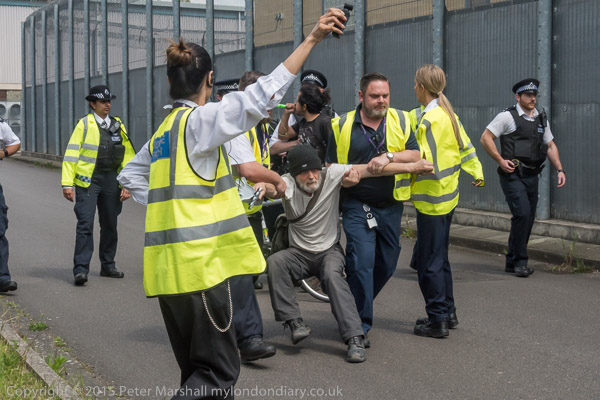 Security
guards manhandle a protester who refused to walk out
Security
guards manhandle a protester who refused to walk out
more pictures
Protesters at Europe's largest detention centre complex at Heathrow, two Category B prisons, Colnbrook & Harmondsworth, managed by private security company MITIE, called for all immigration prisons to be shut, and the racist scapegoating of immigrants to end. They ran past security guards between the two prisons and were able to communicate with some of the prisoners inside, but were quickly forced back to the front of the building when police reinforcements arrived.
The protest here was part of a day of action at all UK detention centres as well as some on mainland Europe, and the Heathrow event was organised by Anti Raids Network. While I've always been welcomed at earlier protests at Harmondsworth and had received an invitation to go to this one, there were just a tiny minority of protesters who made clear they not happy with being photographed, and attempted to impede my work. Others taking pictures were not harassed, and of course most of the time the protest was being recorded both on CCTV and by police evidence gatherers and security guards with cameras. Many of those present knew me and had no problems with being photographed as they have been on previous occasions; curiously it appeared to be mainly some of those who were masked who objected.
Most of the protesters had travelled from central London and they had arrived at the prison complex earlier than I had expected from what I'd been told. When I arrived there was just a small group of people in front of the roadway between the two prisons, who told me I had just missed the others who had rushed past security down the road between the two prisons and were at the back of the Harmondsworth block.
I stood talking for a few minutes, wondering what to do next, then the protesters came into view at the end of the road being harassed by police and security who were trying to move them out. One of the protesters I'd been with rushed past the one remaining security man watching us along the road to join the others, and as he made no real attempt to stop him, another protester followed and I walked down after her.
The protesters held up a large banner with their mobile number for people held in the prison to phone, and made a lot of noise, using megaphones, banging pans and kicking the tall prison fences. Police and security tried to move them on, but were only making very slow progress. After a few minutes a police van drove up and more police were soon able to force them to the front of the complex.
There they continued to protest, making a lot of noise. When they made a lot of noise there was a response from some of those inside, and they were able to call some of the prisoners and hear their stories. As always with protests at these detention centres, those inside were very glad to know that there were people who knew they were imprisoned and supported them.
I walked with some of the protesters as they made their way out of the complex and walked the few yards along the Bath Road to the footpath which runs beside the tall fence on the east side of the Colnbrook prison, soon emerging into a field. Bushes and small trees along the outside of the fence prevent a clear view of the blocks inside, but it was easy to hear some of the prisoners inside shouting. The protesters managed to shout a phone number to them and we could hear some of their stories.
Bashir from Lebanon told us he had been held in detention for 18 months and
that his wife and children need his help, but he is stuck inside, unable to
see them or do anything. Indefinite detention such as this seems a clear breach
of so many of the human rights that everyone in the UK should be entitled
to under our Human Rights Act 1998. Treating people like our system does is
simply shameful.
more pictures
F**k Parade 4: Ripper & Tower Bridge
London. Sun 1 May 2016
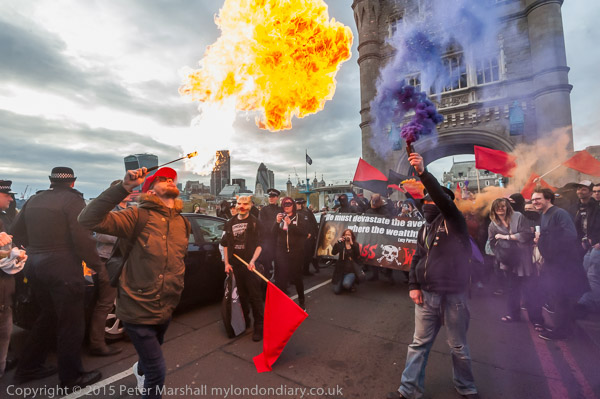
Fire-breathing and flares as partying protesters block
Tower Bridge
more pictures
From Aldgate, the protesters in Fuck Parade 4 (FP4) headed south, going down Leman St to the junction with Cable St, where they briefly diverted to pay a short visit to the Jack the Ripper tacky attraction for the odd perverted tourist which opened in a shop there under false pretences of being a 'museum' and against which Class War and others have held a number of protests.
Here most of the area soon became thick with red smoke, though a line of parked vehicles protected the narrow pavement between shop and street where a line of police face the Class War banner.
But the parade quickly left and moved along a back street to turn down on to Tower Bridge. They moved down the approach on the south-bound carriageway, but on reaching the narrower bridge stopped traffic in both directions. At the middle of the bridge they stopped and watched a display of fire-breathing while others set of flares and shouted.
The protesters then walked slowly across the bridge and turned into Tooley
St, where I left them as they reached Southwark Council Offices. It was getting
late and I'd been on my feet far too long and it was time to get home for
dinner.
more pictures
Anti-Capitalist May Day Street Party Starts
One Commercial St, Aldgate, London. Sun 1 May 2016
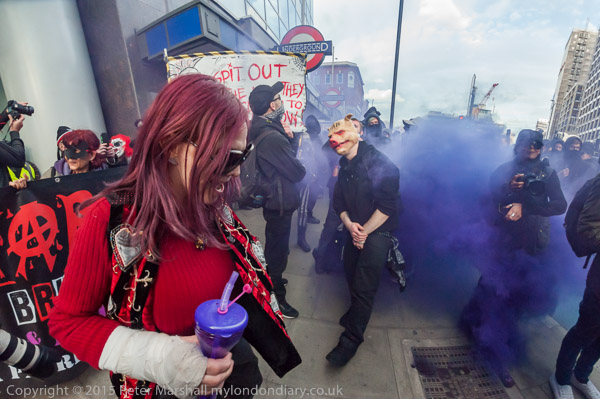
Dancing on the street outside the 'Rich Door' to One
Commercial St
more pictures
Fuck Parade 4 (FP4), the fourth in a series of anti-capitalist street parties organised by anarchists in East London returned to its origin at One Commercial St, the venue for over 30 protests by Class War against social apartheid in housing, and where last year's May Day event was the first of this series of roving music and dancing protests.
Among the several hundred mainly black-clad FP4 party-goers were a number from Class War, who had brought a couple of their banners for the event. I met some of them outside a local pub and took some pictures as a cycle-drawn sound system came to join them. After a few minutes we walked down to One Commercial St together.
There was already a small crowd outside the 'Rich door' of the building when
we arrived and FP4 really got going, while police guarded the building but
made no attempt to interfere with the protest. The music got pretty loud,
and people, many in masks of one kind or another were dancing wildly, and
smoke from blue and move flares was soon drifting across the area.
more pictures
May Day Rally & Gonosangeet
Altab Ali Park, Whitechapel, London. Sun 1 May 2016
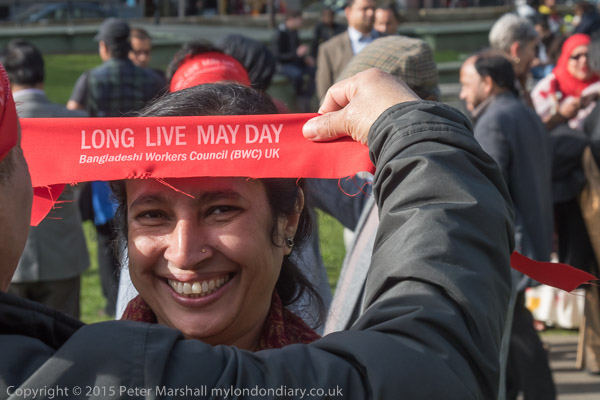
Long Live May Day' was the message on the red headbands of the Bangladeshi
Workers Council
more pictures
The Bangladeshi Workers Council along with Red London, trade unionists,
labour movement, political and community activists held a rally to commemorate
and celebrate May Day at Altab Ali Park in Tower Hamlets.
more pictures
May Day Rally
Trafalgar Square, London. Sun 1 May 2016
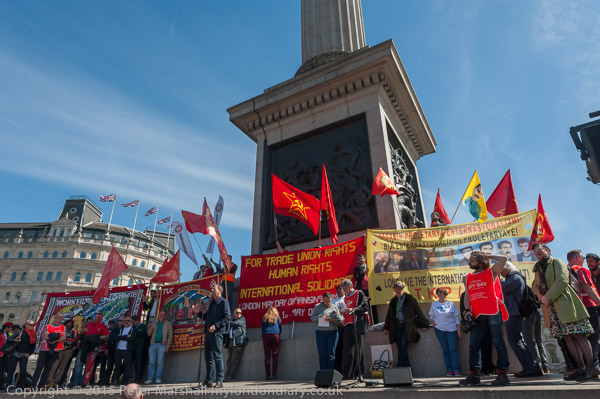
The front of the plinth during the rally
more pictures
Speakers at the rally included NUT General Secretary Christine Blower, UNITE
Regional Secretary for London & Eastern Region Peter Kavanagh, Yannis
Gourtsoyannis from the BMA Junior Doctors' Committee, a representative from
Turkish/Kurdish Community Centre Daymer, Patrick Brill, better known by his
pseudonym Bob and Roberta Smith and Luciana, one of the Brazilians protesting
against the opposition impeachment of Brazilian President Dilma Rousseff which
they say is a coup.
more pictures
Ahwazi Protest at May Day Rally
Trafalgar Square, London. Sun 1 May 2016
Ahwazi Arabs demand an end to repression and ethnic cleansing by Iranians
more pictures
I clambered up onto the plinth of Nelson's Column to photograph the march as it entered Trafalgar Square, as I've done on previous marches. The event stewards were trying to keep the plinth clear of marchers and press, which neither of the two groups felt was in spirit with the fraternal nature of the event, and largely ignored.
As one of the groups came into the square, they set off smoke flares, while others arrived with a sea of red flags. More and more protesters brought flags and banners onto the plinth despite stewards attempting to stop them, including a number of Ahwazi Arabs protesting against their repression over many years by the Iranian regime which they say has stolen their land and is trying to eradicate their culture. Their region, Al Ahwaz (incorporated into Iran as Khuzestan in the 1920s), is the source of much of Iranian oil and is under military control with many Ahwazis being imprisoned and executed.
The Ahwazi protesters then set off flares and protested noisily along the
east side of the plinth as the remaining marchers made their way into the
square.
more pictures
May Day March
Clerkenwell to Trafalgar Square, London. Sun 1 May 2016
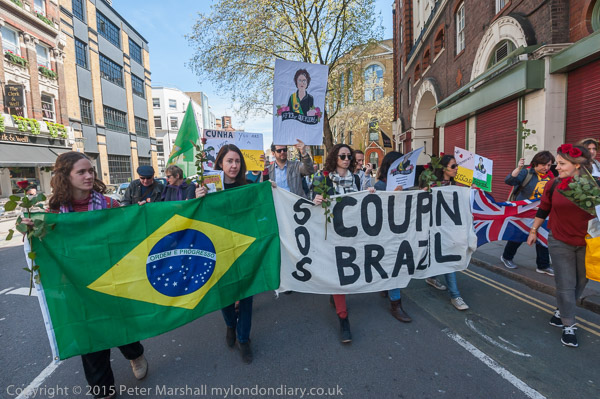
Brazilians on the march protesting against the attempt
to remove their president
more pictures
I photographed the march as it left Clerkenwell Green and going along slowly with it on the Clerkenwell Rd, waiting to see the last marchers as they went past the top end of Leather Lane. There were perhaps five thousand marchers, and they were quite well spread out, so by then the front of the march was probably at Holborn.
I walked down to Chancery Lane tube and changed at Tottenham Court Rd to
get to Charing Cross a few minutes before the front of the march came along
the Strand.
more pictures
May Day at Clerkenwell Green
Clerkenwell Green, London. Sun 1 May 2016

There was intense media interest this year as Labour
leader Jeremy Corbyn came to speak
more pictures
Socialists celebrating international Workers Day including many from London's international and migrant communities gather at Clerkenwell Green where they are addressed by Labour leader Jeremy Corbyn and TUC General Secretary Frances O'Grady before marching through London to a rally at Trafalgar Square.
May day is a time to celebrate the many achievements of struggle by workers over the years and show the determination to fight against attempts to reduce workers rights and to continue the fight for equality and justice.
This year differed from all the previous years I've attended in that the two main speakers of the day came to make their speeches here, TUC General Secretary Frances O'Grady and Jeremy Corbyn, rather than at the final rally in Trafalgar Square.
Jeremy Corbyn was the reason the TV cameras and a large crowd of press, most
of whom were probably at their first ever May Day event, were present. I didn't
bother to join the mob of photographers who tried to photograph him as he
made his way to the bus to speak or to the car to drive away, but was disgusted
to hear on a video of his leaving one of the stewards shouting about there
being so many expensive cameras that might get wrecked.
If anything, attendance at the event overall - apart from the media - seemed
lower than in some previous years, with rather fewer of the Turkish groups
who have been a major part.
While Corbyn was speaking from the upper deck of an open-top bus I deliberately
stood well back to get a decent angle, and avoid being blocked by banners.
But at one point a person carrying a CPGB-ML flag attempted to block Corbyn
from the TV cameras around me - and I think there were a few arguments and
some pushing before he was persuaded to move away.
more pictures
London Images
London, May 2016
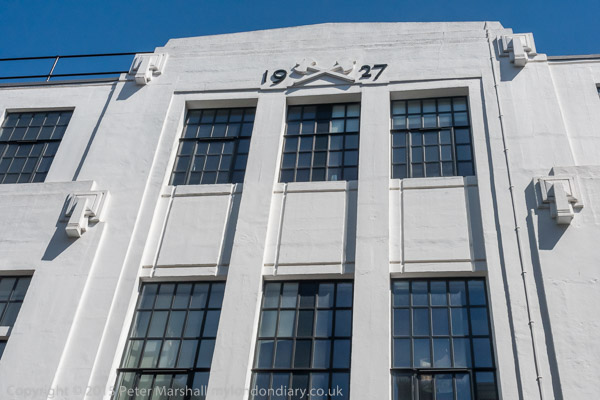
Leather Lane
more pictures
More pictures taken in odd moments as I travelled around London or found myself with a little time to spare between events.
top of page
All pictures on this site are Copyright
© 1999-2019 Peter Marshall ; all rights reserved.
for licences to reproduce pictures or to buy prints or comment on the work,
Payment may be waived for acceptable non-profit
use by unfunded bodies.
But organisations that pay any staff should also pay photographers.
